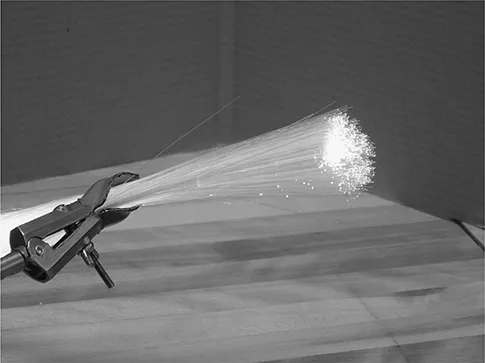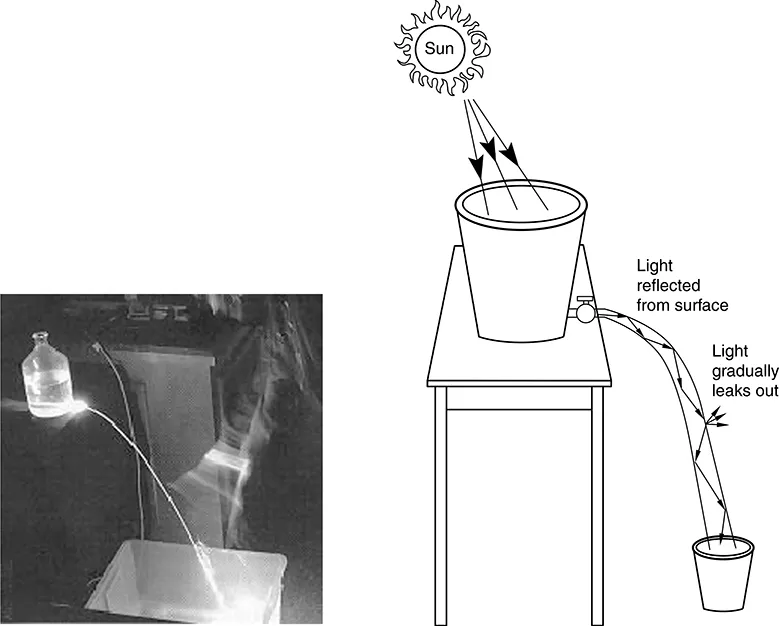22.1 INTRODUCTION
Fibre optic cables transmit data through very small cores at the speed of light. Significantly different from copper cables, fibre optic cables offer high bandwidths and low losses, which allow high data-transmission rates over long distances. Light propagates throughout the fibre cables according to the principle of total internal reflection.
There are three common types of fibre optic cables: single-mode, multimode, and graded-index. Each has its advantages and disadvantages. There also are several different designs of fibre optic cables, each made for different applications. In addition, new fibre optic cables with different core and cladding designs have been emerging; these are faster and can carry more modes. While fibre optic cables are used mostly in communication systems, they also have established medical, military, scanning, imaging, and sensing applications. They are also used in optical fibre devices and fibre optic lighting.
This chapter will discuss the fabrication processes used in manufacturing fibre cables. The processes produce a thin flexible glass strand with a diameter even smaller than that of human hair. The chapter will also detail methods of coupling a light source with a fibre cable in the manufacturing of optical fibre devices. It will also compare fibre and copper cables and describe the applications of fibre optic cables in many fields and sectors of modern society. Finally, this chapter will present four experimental cases, including fibre cable inspection and handling, fibre cable end preparation, numerical aperture measurements and calculations, and fibre cable power output intensity measurements and calculations.
22.2 THE EVOLUTION OF FIBRE OPTIC CABLES
The evolution of optical communication systems dates back to the early 1790s, when the French engineer Claude Chappe (1763–1805) invented the optical telegraph. His system involved a series of semaphores mounted on towers, where human operators relayed messages from one tower to the next. This was certainly an improvement over hand-delivered messages. But by the mid-nineteenth century, the optical telegraph was replaced by the electric telegraph, leaving behind a legacy of Telegraph Hills.
In 1841, Swiss physicist Daniel Colladen (1802–1893) and French physicist Jacques Babinet (1794–1872) showed in their popular science lectures that light could be guided along jets of water for fountain displays. Then in 1870, Irish physicist John Tyndall (1820–1893) demonstrated the light-pipe phenomenon at the Royal Society in England. Tyndall directed a beam of sunlight into a container of water and opened the spout. Water flowed out in a jet, and the pull of gravity bent the water into a parabolic shape, shown in Figure 22.1. Light was trapped inside the water jet by the total internal reflection phenomena. The light beam bounced off the top surface, then off the lower surface of the jet, until turbulence occurred in the flowing water and broke up the beam. This experiment marked the first research into the guided transmission of light by an interface between two optical materials.
In 1880, Alexander Graham Bell patented an optical telephone system that he called the Photophone, but his earlier invention—the telephone—proved far more practical. While Bell dreamed of sending signals through the air, the atmosphere did not transmit light as reliably as wires carried electricity. For the next several decades, though light was used for a few special applications such as signaling between ships, inventions using optical communication gathered dust on the shelf. Bell donated his Photophone to the Smithsonian Institution.
Ultimately, a new light-guiding technology that slowly took root solved the problem of optical transmission, The technology depended on the phenomenon of total internal reflection, which can confine light in an optical material that is surrounded by another optical material with a lower refractive index, such as glass in air. However, it was a long time before this method was adapted for communications.
Optical fibres went a step further. These are essentially transparent rods of glass or plastic stretched until they are long and flexible. During the 1920s, John Logie Baird in England and Clarence W. Hansell in the United States patented the idea of using arrays of hollow pipes or transparent rods to transmit images for television or facsimile systems. British Patent Spec 20,969/27 was registered to J. L. Baird, and US Patent 1,751,584 was granted to C. W. Hansell in 1930 for the scanning and transmission of a television image via fibres. Also in 1930, H. Lamm, in Germany, demonstrated light transmission through fibres. The next reported activity in this field took place in 1951, when A. C. S. van Heel in Holland and Harold H. Hopkins and Narinder S. Kapany of Imperial College in London investigated light transmission through bundles of fibres. While van Heel coated his fibres with plastic, Kapany explored fibre alignment, and as reported in his book Fibre Optics, produced the first undistorted image through an aligned bundle of uncoated glass fibres.
Neither van Heel nor Hopkins and Kapany made bundles that could carry light far, but their reports sparked the fibre optics revolution. The crucial innovation was made by van Heel, stimulated by a conversation with the American optical physicist Brian O’Brien. While all earlier fibres were bare, with total internal reflection at a glass–air interface, Heel covered a bare fibre of glass or plastic with a transparent cladding of lower refractive index. This protected the total reflection surface from losses and greatly reduced crosstalk between fibre cables. The next key step was the development of glass-clad fibres by Lawrence Curt...


